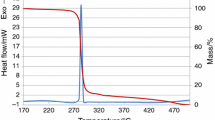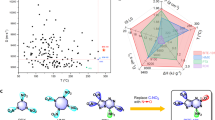Abstract
The new polycyclic nitramine 2,4,6,8,10,12-hexanitrohexaazaisowurtzitane (HNIW) has been focused as a considerable amount of research recently on investigating its polymorphs, relative stability, and respective reaction chemistry. It is known as CL-20 popularly, CL-20 is a very high-energy and relatively high oxygen balance value crystalline compound whose method of synthesis and detailed performance data are still classified. 5-oxo-3-nitro-1,2,4-triazole (NTO, or nitrotriazolone) was an insensitive molecule comparison general explosives, and the NTO based polymer bonded explosives (PBX) was a low vulnerability explosive. Both energetic materials are all very important high explosives, which is used in a variety of military formulations widely owing to the properties of high energy and desensitization of PBX, many researchers have demonstrated the usefulness of above two energetic materials in explosive component. In this work, the thermal decomposition characteristics of explosives CL-20 and NTO were studied using thermal analytical techniques (TG, DSC), then the compatibility of above two explosives with silicone rubber, and the decomposition kinetic parameters such as activation energies of decomposition, the frequency factor of the decompose reaction are also evaluated by non-isothermal DSC techniques.
Similar content being viewed by others
References
S. Borman, C&EN, 1994 Jan. 17, 18–24.
HE Kissinger (1957) Anal. Chem. 29 217 Occurrence Handle10.1021/ac60131a045
T Ozawa (1970) J. Thermal Anal. 2 301 Occurrence Handle1:CAS:528:DyaE3MXmvVaisw%3D%3D Occurrence Handle10.1007/BF01911411
PG Hall (1971) J. Chem. Soc., Faraday Trans., Part 2 67 556 Occurrence Handle1:CAS:528:DyaE3MXhtVersbw%3D Occurrence Handle10.1039/tf9716700556
M Herrmann W Engel N Eisenreich (1992) Propellants, Explos., Pyrotech. 17 190 Occurrence Handle1:CAS:528:DyaK38Xltlequ7c%3D Occurrence Handle10.1002/prep.19920170409
ZR Liu CM Yin ChY Wu MN Chang (1986) Propellants, Explos., Pyrotech. 11 11 Occurrence Handle10.1002/prep.19860110104
J Harris (1976) Thermochim. Acta 14 183 Occurrence Handle1:CAS:528:DyaE28XhtVOqtbs%3D Occurrence Handle10.1016/0040-6031(76)80067-6
MO Hemmila (1982) J. Thermal Anal. 25 135 Occurrence Handle1:CAS:528:DyaL3sXhvVajtLw%3D Occurrence Handle10.1007/BF01913062
G. Krien, Proceeding of lst Symposium on Chemical Problems Connected with the Stability Explosives, 1967, 66.
D Skinner D Olson A Block-Bolten (1997) Propellants, Explos., Pyrotech. 23 34 Occurrence Handle10.1002/(SICI)1521-4087(199802)23:1<34::AID-PREP34>3.0.CO;2-V
DG Patil TB Brill (1991) Combust. Flame 87 145 Occurrence Handle1:CAS:528:DyaK38XitFOmsr4%3D Occurrence Handle10.1016/0010-2180(91)90164-7
DG Patil TB Brill (1993) Combust. Flame 92 456 Occurrence Handle1:CAS:528:DyaK3sXhvFClurk%3D Occurrence Handle10.1016/0010-2180(93)90155-V
M Geetha UR Nair DB Sarwade GM Gore SN Asthana H Singh (2003) J. Therm. Anal. Cal. 73 913 Occurrence Handle1:CAS:528:DC%2BD3sXnsVersL8%3D Occurrence Handle10.1023/A:1025859203860
S Jirong C Zhaxou H Rongzu X Heming L Fuping (1999) J. Therm. Anal. Cal. 58 257 Occurrence Handle1:CAS:528:DC%2BD3cXhtVShtL8%3D Occurrence Handle10.1023/A:1010190811770
X Yi H Rongzu Z Tonglai L Fuping (1993) J. Therm. Anal. Cal. 39 41
N Tanaka (1996) J. Therm. Anal. Cal. 46 1021 Occurrence Handle1:CAS:528:DyaK28XjtF2mur0%3D
G Liptay J Nagy A Borbély-Kuszmann JCh Weil (1987) J. Therm. Anal. Cal. 32 1683 Occurrence Handle1:CAS:528:DyaL1cXktVOktbs%3D
MF Foltz CL Coon AL Nichols (1994) Propellants, Explos., Pyrotech. 19 19 Occurrence Handle1:CAS:528:DyaK2cXisVyksL8%3D Occurrence Handle10.1002/prep.19940190105
MF Foltz CL Coon AL Nichols (1994) Propellants, Explos., Pyrotech. 19 133 Occurrence Handle1:CAS:528:DyaK2cXktlyksLg%3D Occurrence Handle10.1002/prep.19940190305
Author information
Authors and Affiliations
Corresponding author
Rights and permissions
About this article
Cite this article
Lee, JS., Jaw, KS. Thermal decomposition properties and compatibility of CL-20, NTO with silicone rubber. J Therm Anal Calorim 85, 463–467 (2006). https://doi.org/10.1007/s10973-005-7325-0
Received:
Accepted:
Published:
Issue Date:
DOI: https://doi.org/10.1007/s10973-005-7325-0




